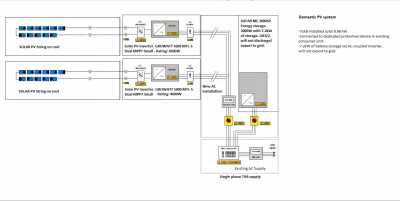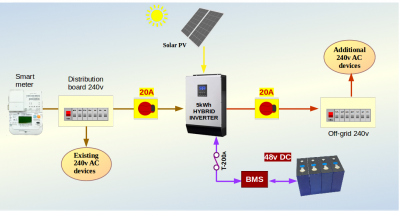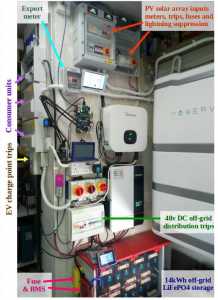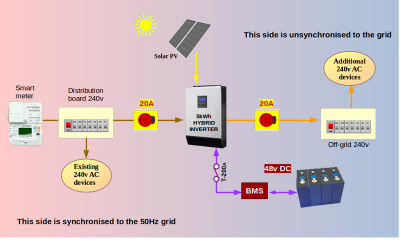@transparent this is my current layout (but I have a bigger battery now). Ideally I just want to put it along side after the first one to pick up anything excess. Because my PV is over 8kw I often have excess PV in the summer. We do dump a lot into AC, or the swimming pool heater, but there is always plenty left. Ideally I also want grid tie to make maximum use of Octopus Go in the winter.
@transparent Can I query the mechanism you use to prevent grid export for your system, as described in one of your previous posts in this thread?
Posted by: @transparentIt currently supplies a 14kWh battery from either the Grid or solar.
Alternatively, what was the plan for the retrofit system for @hydros in this post?
Posted by: @transparentbecause that combination wasn't on the ENA list, the current-limiting system within the existing (G98-installed) PowerVault battery was no longer 'trusted'
I take it the problem is coordinating two independent limiting systems to limit the total power exported at any given moment, hence the combination needs approval. Would some kind of independent G100 limiter device somewhere between the meter and the exporting unit meet the DNO's requirements? Yes, the linked to device does not have a price, and if you have to ask ...
After this journey into uncertainty about fitting batteries/inverters, I can't decide between
- getting no storage (and probably not bothering with solar panels);
- getting solar panels and storage installed in one go (and have the batteries cause the ceiling to sag, and lithium plate/cook in the loft);
- getting solar panels, DIY-ing batteries and taking the bulk of the house off grid (topping up in winter using a battery charger to ensure energy can never flow back to the grid).
The first option will probably happen in my case, since the group-buy scheme has 35% more takers than expected, and I suspect finding more capacity for installers in the area will be pretty tricky/unprofitable.
Let me address the point made by @batalto first...
Posted by: @bataltoBecause my PV is over 8kw I often have excess PV in the summer.
Exactly. You've hit the nail on the head.
What you need is a double-pole switch to divert one of your two solar arrays from the existing grid-tied inverter, and connect instead to a separate off-grid system. This video clip shows the arrangement operating in a self-built "string combiner" box.
Please note that the double-pole Manual Transfer Switch must be DC rated. Each of the four pairs of switching contacts has its own arc-suppression 'ladder'. When the contacts open, a pair of magnets pulls the resulting arc into the ladder's plates and quenches it. This is a safety requirement.
DC switches/MCBs like this are marked with their polarisation and must be connected the right way around.
The switch in the above video is manufactured by FEEO in China. The coloured tags on the levers have been added by me.
Save energy... recycle electrons!
Posted by: @chickenbigCan I query the mechanism you use to prevent grid export for your system, as described in one of your previous posts in this thread?
Yes, please do query. This is a very important point!
I alluded to the mechanism I use to prevent grid-export higher up this thread, but it warrants being repeated here for clarification.
Posted by: @transparentThe sort of inverter I've been investigating over the past year is the type which does not (and cannot) export back to the Grid.
This design has its own internal 50Hz generator, thus making its 240v AC output unsynchronised.
And here's a generic diagram of such an arrangement:
There is only one parameter on the UK electricity grid that is a constant - and that's the 50Hz frequency.
It is not possible to connect any generation source to the grid unless the frequency is first aligned.
I've seen this for myself at a hydro-electric plant where a turbine was being run up. The engineer watched a gauge until the arrow pointed directly upwards. At that point it was safe to 'throw the switch' without the fuses blowing!
Exactly the same principle applies to my tiny 5kW inverter. Since it contains its own 50Hz oscillator, it is unsynchronised to the national 50Hz grid. If I were to try connecting it to the grid then it would be pitched into an unequal battle against the combined power from all the commercial generation plants of Europe. Guess who's going to win?!
In conclusion, a solar inverter must fall within one of two possible categories:
- it is grid-tied, using the external 50Hz frequency to synchronise its output to that of the National Grid
- it is off-grid, creating its own 50Hz for its output from an internal oscillator
Save energy... recycle electrons!
Posted by: @chickenbig...
2. getting solar panels and storage installed in one go (and have the batteries cause the ceiling to sag, and lithium plate/cook in the loft);
...
I realise your installer wants to install the batteries in the loft, but let's not forget you're the customer. You don't even need to argue on technical grounds; if you want to retain the loft space as somewhere to install your Scalextric track, that's what the installer must work around.
105 m2 bungalow in South East England
Mitsubishi Ecodan 8.5 kW air source heat pump
18 x 360W solar panels
1 x 6 kW GroWatt battery and SPH5000 inverter
1 x Myenergi Zappi
1 x VW ID3
Raised beds for home-grown veg and chickens for eggs
"Semper in excretia; sumus solum profundum variat"
Posted by: @transparentI have a Growatt SPF5000ES here, operating as a totally off-grid inverter. It currently supplies a 14kWh battery from either the Grid or solar.
OK, so I mis-read the post about your current setup and assumed that there was an AC link from the grid to the inverter. I am now just a little unclear about how you charge your battery from the grid. Do you use some kind of high powered charger (e.g. an Elcon 3.3kW battery charger which can be controlled over CANBUS) to move energy one way (from the grid down to the batteries) with no possibility of trying to feed the energy back? If this is the case (and similar to the V2G trial mentioned) what are your efficiencies like?
@chickenbig - my storage battery configurations are under perpetual development, which means that the connections are being changed weekly. I'm attempting to provide answers here on the Forum, whilst simultaneously altering the arrangement. So apologies if what I wrote a week ago has been insufficiently clear. Mea culpa.
It is currently the case that my Growatt SPF5000ES hybrid inverter is indeed receiving sufficient solar input such that it is not configured to charge the 14kWh battery from the grid. However it has the capability to do so. It does not require a separate battery charger unit.
As matters stand the SPF5000SPF has to be configured via its inbuilt screen and menu buttons. Its firmware is designed to give priority to keep the load(s) alive rather than make best use of available storage capacity. That's not what I want, and it's also probably beyond the capability of most people to correctly configure both the Growatt inverter and the battery's BMS to handle the required battery charge/discharge parameters.
You will therefore be unsurprised to learn that I am part of an engineering group who are designing a control system to do this automatically. 🙂
You asked about "moving energy one way (from the grid down to the batteries) with no possibility of trying to feed the energy back". In a word - yes!
The whole point is to have 240v AC devices being powered from the storage battery (off-grid) for most of the time. This means that the electricity being used can be obtained at the cheapest/greenest point.
The main target is to operate a heat-pump by this strategy... which is why it's a subject of considerable interest on this particular forum! But to start with I will be using other existing 240v devices which I can switch between grid-connected and off-grid during short-term test runs. Ie this is a prototype development set-up, as opposed to the fixed installations which usually get mentioned here.
Of course you are quite right to enquire about efficiencies, but that's not an issue which occupies our time at the moment. Once the software is substantially in place, then it will rise higher on the priority list.
Let me also point out that I actually have two separate battery storage systems on trial here.
There is also a grid-tied 8kWh PowerVault unit with a different Growatt inverter supplying solar power to it at 240v AC.
So I'm in a good position to evaluate and offer opinions on both approaches to electricity storage... which I hope will continue to be welcomed here on the forum.
Here's a brief glimpse of the test-rig as it stands today (10th June '22). But there's a lot more still to be installed.
Save energy... recycle electrons!
I've re-jigged the colours/labels on the diagram I posted on the previous page earlier today.
Does this make things clearer?
The inverter in the middle is connected to the 240v grid.
But it cannot export back to the grid. The 240v AC output on the right is unsynchronised and entirely separate.
Save energy... recycle electrons!
If you are not already doing so, why don't you use a Programmable Logic Controller (PLC) to control the operation of the system?
The control system under investigation/development is to receive data inputs which require a lot more software than just a PLC can offer. These include
- weather-forecast (analogue) to assess the heat-requirement for the following day
- sunshine forecast (analogue) to assess how much solar generation is likely
- ToU tariff data per 30min, including one-off changes to a day's schedule
- regional renewable generation data (ie just on the Distribution Grid)
- energy-mix variations per hour
These are subject to licensing arrangements, and can only be addressed by a commercial approach. Open-source hardware/software is not an option.
There must also be a fail-safe arrangement to prevent erratic operation in the event of a hostile 3rd party attack on the UK domestic energy supply.
Does anyone buying a new Smart EV charger even consider that, I wonder?
Save energy... recycle electrons!
Posted by: @transparentThe control system under investigation/development is to receive data inputs which require a lot more software than just a PLC can offer. These include
- weather-forecast (analogue) to assess the heat-requirement for the following day
- sunshine forecast (analogue) to assess how much solar generation is likely
- ToU tariff data per 30min, including one-off changes to a day's schedule
- regional renewable generation data (ie just on the Distribution Grid)
- energy-mix variations per hour
These are subject to licensing arrangements, and can only be addressed by a commercial approach. Open-source hardware/software is not an option.
There must also be a fail-safe arrangement to prevent erratic operation in the event of a hostile 3rd party attack on the UK domestic energy supply.
Does anyone buying a new Smart EV charger even consider that, I wonder?
You are obviously not fully aware of the capabilities of modern PLC's, which are used throughout industry to control very complex systems and of course have to be fully protected from outside interference.
@transparent the Sofar inverter I own has a group on Facebook which has built a controller to do most of this via a raspberry pi. Certainly the forecasting part to optimise the charging on Go based on weather and sunshine. I'm sure the others could be implemented as long as the data is present.
- 26 Forums
- 2,396 Topics
- 54.3 K Posts
- 311 Online
- 6,077 Members
Join Us!
Worth Watching
Latest Posts
-

RE: Fan is clipping ice build up from the front of unit.
@papahuhu I think my problem was just due to unusual we...
By bontwoody , 2 minutes ago
-

RE: Running from backup generaor in powercut?
Here's the Power Cut map from Cornwall at 23:00 last ni...
By Transparent , 2 minutes ago
-

RE: Recommended home battery inverters + regulatory matters - help requested
@jamespa - your diagram with my additions ...
By Transparent , 16 minutes ago
-
RE: New Mitsubishi Ecodan 11.2kW installation - L9 errors and maybe more
Hi @jamespa - thank you again. Yes, I think it pro...
By anotherdaveuk , 1 hour ago
-

RE: ASHP Energy Consumption: Aira 12kW heat pump
Indeed. Present ToU tariffs are based on national sup...
By Transparent , 1 hour ago
-
RE: Help me keep the faith with my air source heat pump installation
@adamk I'm observing my own system at low temperatures ...
By dr_dongle , 2 hours ago
-

RE: Free Ecoheat Heat Pump Install
@deltona Yes older houses are problematic like that, bu...
By bontwoody , 21 hours ago
-
RE: Radiator sizing sanity check
As I mentioned early on the cost of supplying and fitti...
By JamesPa , 23 hours ago
-
RE: Advice for a novice on Mitsubishi Ecodan 6kW
I hadn't spotted that there were two pumps in the UFH (...
By JamesPa , 1 day ago
-
RE: Setback savings - fact or fiction?
Never assume it makes an ass of u and me! You need the...
By JamesPa , 1 day ago
-
RE: Electricity price predictions
Great point, one of the key ones in my chat with Octopu...
By Batpred , 2 days ago
-

RE: New Fogstar 15.5kWh upright solution
Let me point out that there are many Chinese suppliers ...
By Transparent , 2 days ago
-

RE: Weather compensation- why you should use it
@majordennisbloodnok — The Two Ronnies Mastermind sketc...
By cathodeRay , 2 days ago
-
Just realised that this image of the cylinder cupboard ...
By Sheriff Fatman , 2 days ago
-

RE: Rodents! A word of warning for heat pump owners
Two thoughts: 1: Let's ask @david-s if Primary Pro in...
By Transparent , 2 days ago
-
RE: Solis S6-EH1P8K-L-PLUS – Why I Chose It and What I’ve Learned So Far
In the diagram below, I describe my understanding of th...
By Batpred , 2 days ago
-
I need to have a look out for it. I know IBM feeds some...
By Batpred , 2 days ago
-
-
RE: Daikin Atherma ASHP Cycling 6 Times an Hour?
Thanks for your reply. Yes that's a good idea to try a...
By John Marshall , 2 days ago
-

RE: Hot water heating in parallel with space heating
An external heat exchanger would need a pump which woul...
By bontwoody , 2 days ago







